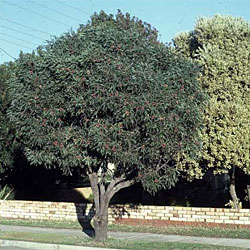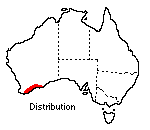Hakea laurina
 |
 |
Pin-cushion Hakea
Hakea laurina (Pin-cushion Hakea) is one of the most admired native plants of south-western Australia, and is grown in quantity in Australia and other countries. In Italy and America its uses include street and hedge planting.
 In
the Australian National Botanic Gardens it is grown singly as a shrub or small
tree reaching 5 m. The best specimens are in open beds of light soil, watered
but well drained. In full sun the species forms an upright shrub with a compact,
rounded head, flowering freely and evenly each year on the well-ripened wood.
Specimens 20 years old in light shade are rather slender and sparse and in this
position they do not flower well or regularly. Others, starved in early years,
are smaller and have never flowered.
In
the Australian National Botanic Gardens it is grown singly as a shrub or small
tree reaching 5 m. The best specimens are in open beds of light soil, watered
but well drained. In full sun the species forms an upright shrub with a compact,
rounded head, flowering freely and evenly each year on the well-ripened wood.
Specimens 20 years old in light shade are rather slender and sparse and in this
position they do not flower well or regularly. Others, starved in early years,
are smaller and have never flowered.
The general impression is of bold and handsome foliage, slightly blue-green, though closer inspection shows that the foliage is blemished at various times of the year with fungus spots. The simple and shapely leaves are widely spaced and wave and curl attractively. They are up to 15 cm long, thick and smooth, with rows of prominent veins. The species is frost tender in the new tip growth made during autumn and some of this is generally lost each winter, unless sheltered by trees. As a precaution, young plants may be covered nightly during winter till about 1 m high.
As early as December tiny new flower buds can be seen, becoming fat and pointed by autumn and covered with ornamental scales, whitened by coverings of fine hairs. In good years they are packed in tight clusters on ripe wood,. nestling among the leaves yet not hidden. Flowering starts towards the end of April, is at its best in July in a mild winter and ends towards the end of August, although in an extremely cold winter flowers are held back and reduced in size. The rounded pin-cushion flower heads are soft cardinal or cherry red, with projecting long styles, white to pale pink on aging. A faint, pleasant scent can be detected and bees have been seen visiting the flowers.
The bright, sturdy globular flower-heads up to 5 cm across, in the middle of a cold winter, on a shrub easy to obtain and grow, make this a good choice for one of the basic plants in a new garden. There are several other hakeas with globular flower heads, but less easy to obtain.
Seed is occasionally found here and is the means of raising young plants, which may also be obtained from nurseries dealing in native species. Almost any garden soil is suitable as long as it is lime-free. Staking is advisable, as plants are weakly rooted and do not hold well in all soils or in exposed positions. At about 1.5 m high a well-grown specimen is heavy and may lean badly.
Root-rot fungus may cause severe die-back of branches, but plants have been known to recover after drying out. Moderate pruning and shaping may be done as required and short stems of flowers may be cut for indoor decoration.
Based on text by ANBG staff (1972)
Name meaning: Hakea laurinaHakea - after Baron von Hake, 20th century botanist; laurina - laurel-like, of the leaves |
![An Australian Government Initiative [logo]](/images/austgovt_brown_90px.gif)

